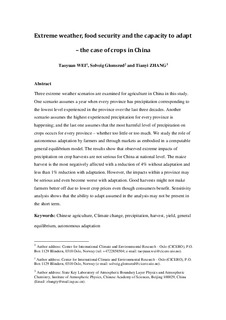Extreme weather, food security and the capacity to adapt – the case of crops in China
Journal article, Peer reviewed
Accepted version

Permanent lenke
http://hdl.handle.net/11250/2477642Utgivelsesdato
2015Metadata
Vis full innførselSamlinger
- Journal articles [478]
Sammendrag
Three extreme weather scenarios are examined for agriculture in China in this study. One scenario assumes a year when every province has precipitation corresponding to the lowest level experienced in the province over the last three decades. Another scenario assumes the highest experienced precipitation for every province is happening; and the last one assumes that the most harmful level of precipitation on crops occurs for every province – whether too little or too much. We studied the role of autonomous adaptation by farmers and through markets as embodied in a computable general equilibrium model. The results show that observed extreme impacts of precipitation on crop harvests are not serious for China at national level. The maize harvest is the most negatively affected with a reduction of 4 % without adaptation and less than 1 % reduction with adaptation. However, the impacts within a province may be serious and even become worse with adaptation. Good harvests might not make farmers better off due to lower crop prices even though consumers benefit. Sensitivity analysis shows that the ability to adapt assumed in the analysis may not be present in the short term.
Beskrivelse
This is a post-peer-review, pre-copyedit version of an article published in Food Security. The final authenticated version is available online at: http://dx.doi.org/10.1007/s12571-015-0420-6